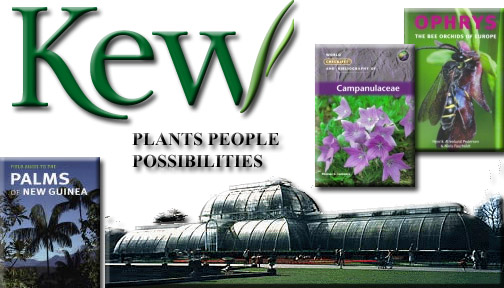

Please note, Kew raised prices recently so prices in these catalogs may be lower/higher due to fluctuations with foreign exchange rates, just email scott for current pricing.
New
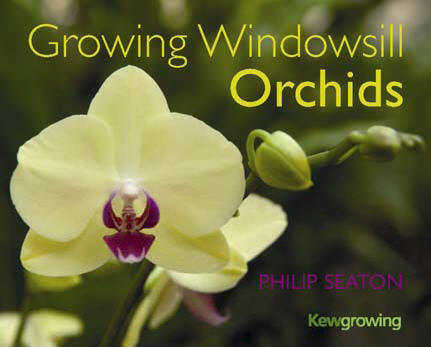 Growing
Windowsill Orchids. Philip Seaton. due July 2010. From elegant warmth-loving
moth orchids to exquisite slipper orchid, Growing Windowsill Orchids
tells you everything you need to know about successful orchid growing in the
home. Written in non-technical language and copiously illustrated with
photographs and informative line drawings this book provides advice on how to
choose the best plant, how to look after your orchid when it has finished
flowering and how to get it to flower again year after year. Cultivation advice
includes the best place to grow your plants in the home, how frequently to water
and feed your plants and how to keep them free from pests and disease.
Step-by-step instructions explain how and when to repot your plants, what
composts to use and when to water. For readers who wish to learn more about
their orchids, Phil delves into the basis of orchid biology, conservation and
how plants get from the nursery to your shop. 60 pp. Colour photographs and
illustrations. Format: Paperback. ISBN: 978 1 84246 427 4. $15.00
Growing
Windowsill Orchids. Philip Seaton. due July 2010. From elegant warmth-loving
moth orchids to exquisite slipper orchid, Growing Windowsill Orchids
tells you everything you need to know about successful orchid growing in the
home. Written in non-technical language and copiously illustrated with
photographs and informative line drawings this book provides advice on how to
choose the best plant, how to look after your orchid when it has finished
flowering and how to get it to flower again year after year. Cultivation advice
includes the best place to grow your plants in the home, how frequently to water
and feed your plants and how to keep them free from pests and disease.
Step-by-step instructions explain how and when to repot your plants, what
composts to use and when to water. For readers who wish to learn more about
their orchids, Phil delves into the basis of orchid biology, conservation and
how plants get from the nursery to your shop. 60 pp. Colour photographs and
illustrations. Format: Paperback. ISBN: 978 1 84246 427 4. $15.00
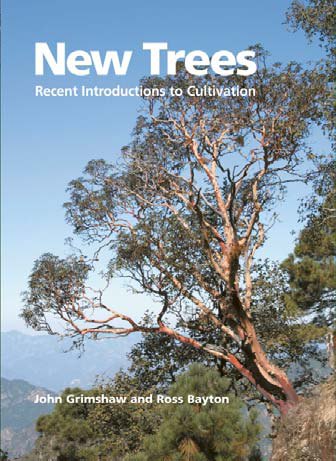 New
Trees. Recent Introductions to Cultivation. John Grimshaw & Ross Bayton.
2010. This comprehensive volume, commissioned by the International Dendrology
Society, covers more than eight hundred tree species that have been introduced
to cultivation in the United Kingdom, Europe, and North America in recent
decades. Up until now there has been no comparable source of information.
Featuring horticultural notes from a network of growers and enthusiasts, backed
up by data from recent scientific studies, the book presents a remarkable amount
of information in a fashion accessible to amateurs as well as specialists. More
than one hundred line drawings and nearly six hundred photographs—many
portraying rarely seen trees—offer aids to identification. Introductory chapters
covering conservation and modern techniques of tree-growing, and a comprehensive
glossary and bibliography, round out the volume and make New Trees
incomparable—and indispensable. 992 pages, 580 color plates, 100 line drawings.
ISBN: 9781842461730. $163.00
New
Trees. Recent Introductions to Cultivation. John Grimshaw & Ross Bayton.
2010. This comprehensive volume, commissioned by the International Dendrology
Society, covers more than eight hundred tree species that have been introduced
to cultivation in the United Kingdom, Europe, and North America in recent
decades. Up until now there has been no comparable source of information.
Featuring horticultural notes from a network of growers and enthusiasts, backed
up by data from recent scientific studies, the book presents a remarkable amount
of information in a fashion accessible to amateurs as well as specialists. More
than one hundred line drawings and nearly six hundred photographs—many
portraying rarely seen trees—offer aids to identification. Introductory chapters
covering conservation and modern techniques of tree-growing, and a comprehensive
glossary and bibliography, round out the volume and make New Trees
incomparable—and indispensable. 992 pages, 580 color plates, 100 line drawings.
ISBN: 9781842461730. $163.00
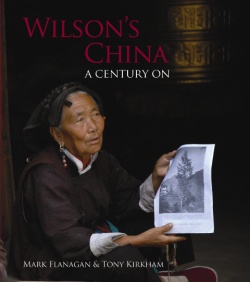 Wilson’s
China: a Century on. Mark Flanagan and Tony Kirkham. 2009. Ernest Wilson was
the foremost plant collector of his generation, responsible for introducing over
1,000 species to our gardens in the West. Wilson's legacy includes glass plate photographs taken in
Sichuan at the beginning of the 20th century, depicting landscapes, villages,
river scenes, people and plants, veteran and exceptional trees. Armed with
copies of these images and with the help of Chinese guides and local knowledge
the authors retraced Wilson's footsteps, taking photographs themselves. The
result, a splendid series of ‘then and now’ images, are a key feature of this
informative homage to a great plant hunter. Further photographs provide a
fascinating insight into the changes and continuities in China over a hundred
year period, and offer a captivating glimpse of people and places in the remote
province of Sichuan. ISBN: 978 1 84246 394 9. illustrated with color and B&W
photos. hardcover. 256 pp. $56.00
Wilson’s
China: a Century on. Mark Flanagan and Tony Kirkham. 2009. Ernest Wilson was
the foremost plant collector of his generation, responsible for introducing over
1,000 species to our gardens in the West. Wilson's legacy includes glass plate photographs taken in
Sichuan at the beginning of the 20th century, depicting landscapes, villages,
river scenes, people and plants, veteran and exceptional trees. Armed with
copies of these images and with the help of Chinese guides and local knowledge
the authors retraced Wilson's footsteps, taking photographs themselves. The
result, a splendid series of ‘then and now’ images, are a key feature of this
informative homage to a great plant hunter. Further photographs provide a
fascinating insight into the changes and continuities in China over a hundred
year period, and offer a captivating glimpse of people and places in the remote
province of Sichuan. ISBN: 978 1 84246 394 9. illustrated with color and B&W
photos. hardcover. 256 pp. $56.00
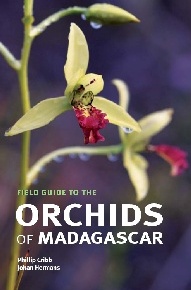 Field
Guide to the Orchids of Madagascar. Phillip Cribb and Johan Hermans. 2009.
Field
Guide to the Orchids of Madagascar. Phillip Cribb and Johan Hermans. 2009.
ISBN: 978 1 84246 158 7. paperback. 456 pp. 750 color photos. $120.00
Flora of the Guianas Series A: Phanerogams Fascicle 27. 2009. includes: 71. Cyrillaceae, 79. Theophrastaceae, 86. Habdodendraceae, 90. Proteaceae, 100. Combretaceae, 113. Dichapetalaceae, 167. Limnocharitaceae, 168. Alismataceae . 214 pp, line drawings, fold out map. Paperback. ISBN: 978 1 84246 418 2. $88.00
Field Guide to the Plants of Northern Botswana including the Okavango Delta. Alison and Roger Heath. 2009.
588 pp., over 2000 colour photographs, Hardback. ISBN: 978 1 84246 183 9. $114.00
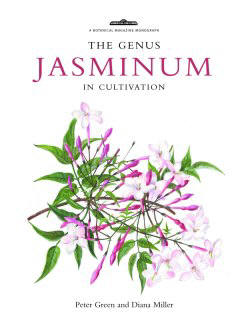 The
Genus Jasminum in Cultivation. A Botanical Magazine Monograph.
Peter Green and Diana Miller. Due June 2009. ISBN: 978 1 84246 011 5. 166 pp.,
35 colour botanical paintings, 30 color photographs, and 18 line drawings.
Hardcover.
List Price $66.00
Jasmines have long
been cultivated for their intoxicating scent, reminiscent of Arabian nights or
warm summer evenings. The Egyptians were probably the first to grow jasmine on a
large scale and it is recorded as an exotic perfume used by decadent Romans in
the first century AD. Since then they have been continuously grown both for
their perfume and their outstanding qualities as winter flowering climbers. This
book describes in detail the species which are cultivated in gardens, their
habitat and distribution in the wild, and their propagation. A chapter on the
uses of jasmine scent in the perfume industry has been contributed by Robert
Calkin, and why it is such an important constituent of some of the world’s most
exclusive scents. Nearly all the cultivated species are illustrated by
contemporary or old botanical paintings, line drawings and photographs.
The
Genus Jasminum in Cultivation. A Botanical Magazine Monograph.
Peter Green and Diana Miller. Due June 2009. ISBN: 978 1 84246 011 5. 166 pp.,
35 colour botanical paintings, 30 color photographs, and 18 line drawings.
Hardcover.
List Price $66.00
Jasmines have long
been cultivated for their intoxicating scent, reminiscent of Arabian nights or
warm summer evenings. The Egyptians were probably the first to grow jasmine on a
large scale and it is recorded as an exotic perfume used by decadent Romans in
the first century AD. Since then they have been continuously grown both for
their perfume and their outstanding qualities as winter flowering climbers. This
book describes in detail the species which are cultivated in gardens, their
habitat and distribution in the wild, and their propagation. A chapter on the
uses of jasmine scent in the perfume industry has been contributed by Robert
Calkin, and why it is such an important constituent of some of the world’s most
exclusive scents. Nearly all the cultivated species are illustrated by
contemporary or old botanical paintings, line drawings and photographs.
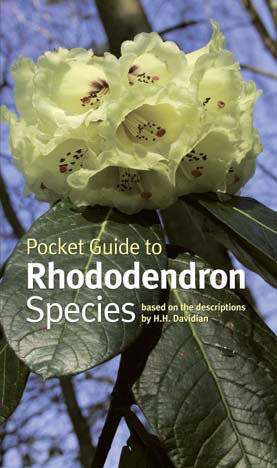 Pocket
Guide to Rhododendron Species – based on the descriptions of H.H. Davidian.
J.F. McQuire and M.L.A. Robinson. Due June 2009. ISBN: 978 1 84246 148 8. 704
pp., Over 700 colour photographs. Hardcover.
List Price $118.00,
Pocket Guide to Rhododendron Species highlights the most important morphological
features relevant to the recognition and identification of virtually every
rhododendron species currently in cultivation. At the heart of the book are over
700 colour photographs, used to illustrate every aspect of the plants, and
succinct descriptions which include flower colour and flowering time, habit,
height, performance and, critically, leaf characteristics to aid identification
even when plants are not in bloom. The book uses fully modern taxonomic
descriptions to the genus. A perfect companion whether you are touring a
botanical garden or trekking in the remote Himalayas.
Pocket
Guide to Rhododendron Species – based on the descriptions of H.H. Davidian.
J.F. McQuire and M.L.A. Robinson. Due June 2009. ISBN: 978 1 84246 148 8. 704
pp., Over 700 colour photographs. Hardcover.
List Price $118.00,
Pocket Guide to Rhododendron Species highlights the most important morphological
features relevant to the recognition and identification of virtually every
rhododendron species currently in cultivation. At the heart of the book are over
700 colour photographs, used to illustrate every aspect of the plants, and
succinct descriptions which include flower colour and flowering time, habit,
height, performance and, critically, leaf characteristics to aid identification
even when plants are not in bloom. The book uses fully modern taxonomic
descriptions to the genus. A perfect companion whether you are touring a
botanical garden or trekking in the remote Himalayas.
Flora Zambesiaca Volume 12 Part 2. Dioscoreaceae, Taccaceae, Burmanniaceae, Pandanaceae, Velloziaceae, Colchicaceae, Liliaceae, Smilacaceae. Jonathan Timberlake. 2009. ISBN: 978 1 84246 193 8. 214 pp., 52 line drawings. Paperback. $118.00 The Flora Zambesiaca series provides comprehensive descriptive accounts of the flowering plants and ferns native and naturalised in Zambia, Malawi, Mozambique, Zimbabwe, Botswana and the Caprivi Strip. Published in paperback following a modified Bentham & Hooker system, as parts or as whole volumes as and when they are complete.
Flora of Tropical East Africa: Lamiaceae (Labiatae). H.J. Beentje and S.A. Ghazanfar. 2009. ISBN: 978 1 84246 372 7. 432 pp., line drawings. Paperback. $170.00 A descriptive account of the flowering plants and ferns native and naturalised in Kenya, Tanzania and Uganda, together with information on exotic ornamental and crop plants. At least one species per genus is illustrated, and the bibliography and synonymy are sufficiently detailed to explain the nomenclature and taxonomic circumscriptions within a broad regional context. The Flora is a part work published in fascicles (paperback). FTEA Lamiaceae is the 250th part of the Flora published, in 2009, Kew’s 250th anniversary year.
World Checklist of
Myrtaceae. Rafale Govaerts et al. Due December 2008.
ISBN: 978 1 84246 391 8. 470 pp. Paperback. $144.00
Myrtaceae is the ninth largest flowering plant family; it is economically
important in the production of timber, gums, essential oils, fruits and spices,
and contains many commonly cultivated ornamentals. The family is particularly
rich in large genera, often found in some of the world's most threatened
ecosystems, where their fruits comprise an important part of the diet of
primates and birds. The similarity of Myrtaceae species is high, and its
taxonomic and nomenclatural history is complex, resulting in notorious
difficulties in basic identification, inventory compilation and floristic
treatment.
The World Checklist of Myrtaceae is a much needed work that lists all validly
published names in the family, providing the source of their publication and
indicating which names are currently accepted and which are synonyms. It will be
respected as the standard nomenclatural reference for further research into this
important family.
Flora of the Guianas.
Series A: Phanerogams Fascicle 26. 155 (Gesneriaceae).
Described by L.E. Skog & C. Feuillet. 2008. ISBN: 978 1 84246 393 2. 136 pp., 25
line drawings. Folding map. Softback. $88.00
Flora of Tropical East
Africa: Hymenophyllaceae. H J Beentje. 2008. ISBN: 978 1
84646 373 4. 34pp., 13 figs. Paperback. $42.00
Being a descriptive account of the flowering plants and ferns native and
naturalised in Kenya, Tanzania and Uganda, together with information on exotic
ornamental and crop plants.
Flora Zambesiaca, Volume
13, Part 1: Asparagaceae, Behniaceae, Agavaceae, Anthericaceae, Alliaceae,
Agapanthaceae, Amaryllidaceae. Edited by Jonathan
Timberlake. 2008. ISBN: 978 1 84246 190 7. 140 pp. Softcover. $96.00
The Genus Macaranga - a prodromus. Timothy C. Whitmore. 2008. Macaranga is a genus in the family Euphorbiaceae. It comprises trees, treelets and some lianas, many of which are conspicuous large-leafed pioneers of disturbed habitats. Some species have ant associations. There are 257 species, of which 21 are newly described here. The genus is most diverse in South East Asia and New Guinea but also occurs in Africa and Madagascar (37 species), continental Asia (30 species), the Pacific Islands (24 species) and Australia (7 species). The species can be identified with the help of either regional keys or keys within informal species groups. Twenty-five species are illustrated. 257 species descriptions, 21 new species, ID keys, 25 species illustrated. 312 pp. $98.00
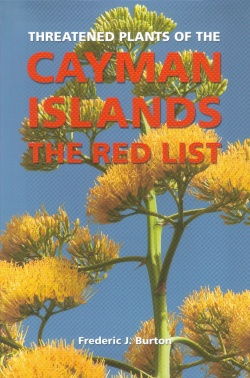 Threatened
Plants of the Cayman Islands: The Red List. Frederic J. Burton. 2008. This
is the first Red List assessment of the entire Cayman Islands flora, covering
all 415 species and varieties considered to be truly native to the islands. Full
color photographs and status accounts for all the endemic and near-endemic
plants represent the core of the work, with background chapters on vegetation
communities, threats and dangers, protected areas and climatic factors. A
substantial and comprehensive listing of the native Cayman Island flora is
presented in tabular form after the species accounts; and an accompanying CD-ROM
contains an excellent, illustrated, key to the classification of the plant
communities. 105pp. 235 x 155 mm. Col. photos. CD-ROM in rear plastic pocket.
Softback. ISBN 978 1 84246 220 1. $40.00
Threatened
Plants of the Cayman Islands: The Red List. Frederic J. Burton. 2008. This
is the first Red List assessment of the entire Cayman Islands flora, covering
all 415 species and varieties considered to be truly native to the islands. Full
color photographs and status accounts for all the endemic and near-endemic
plants represent the core of the work, with background chapters on vegetation
communities, threats and dangers, protected areas and climatic factors. A
substantial and comprehensive listing of the native Cayman Island flora is
presented in tabular form after the species accounts; and an accompanying CD-ROM
contains an excellent, illustrated, key to the classification of the plant
communities. 105pp. 235 x 155 mm. Col. photos. CD-ROM in rear plastic pocket.
Softback. ISBN 978 1 84246 220 1. $40.00
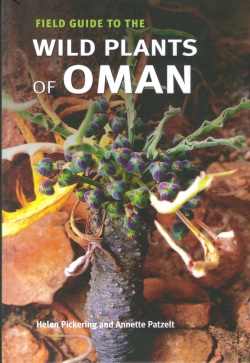 Field
Guide to the Wild Plants of Oman. Helen Pickering and Annette Patzelt. 2008.
Designed for outdoor enthusiasts, the Field Guide to the Wild Plants of Oman
will also be valued by those with more specialised botanical interests. The
short introduction provides an insight into Oman’s geography and environmental
diversity. The main sections cover 250 common species, and each account is
enhanced by fascinating colour photographs which enable quick identification.
For ease of use, plants are grouped according to the colour of their most
conspicuous feature, usually flowers, with additional sections for trees and
grasses. Within each colour group they are organised alphabetically by botanical
family. A short description gives details of appearance, habitat, uses and
worldwide distribution. The addition of a glossary of botanical terms, a
bibliography and indexes of scientific and vernacular names, make this an
invaluable reference for anyone with an interest in the fascinating flora of
Oman. 288pp. 234 x 156 mm. Colour photographs throughout. Hardcover. ISBN 978 1
84246 177 8. $78.00
Field
Guide to the Wild Plants of Oman. Helen Pickering and Annette Patzelt. 2008.
Designed for outdoor enthusiasts, the Field Guide to the Wild Plants of Oman
will also be valued by those with more specialised botanical interests. The
short introduction provides an insight into Oman’s geography and environmental
diversity. The main sections cover 250 common species, and each account is
enhanced by fascinating colour photographs which enable quick identification.
For ease of use, plants are grouped according to the colour of their most
conspicuous feature, usually flowers, with additional sections for trees and
grasses. Within each colour group they are organised alphabetically by botanical
family. A short description gives details of appearance, habitat, uses and
worldwide distribution. The addition of a glossary of botanical terms, a
bibliography and indexes of scientific and vernacular names, make this an
invaluable reference for anyone with an interest in the fascinating flora of
Oman. 288pp. 234 x 156 mm. Colour photographs throughout. Hardcover. ISBN 978 1
84246 177 8. $78.00
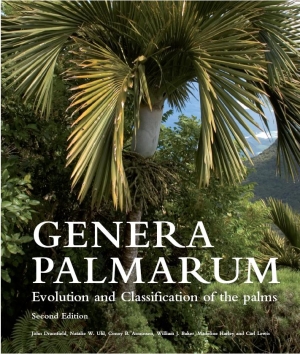 Genera
Palmarum: The Evolution & Classification of Palms. Dransfield, N.W. Uhl, et
al. 2008. Genera Palmarum – The Evolution and Classification of Palms is a
completely rewritten edition of the acclaimed standard reference work for the
palm family, a group of plants of immense economic and horticultural
significance. In the new edition, genus treatments include complete
descriptions, nomenclature, etymology and discussions of diversity,
distribution, phylogeny, morphology, uses and ecology. All genera of palms are
illustrated with analytical plates, maps and numerous photographs, mostly taken
in the wild. The introduction consists of essays on the structure of palms,
their pollen, cytology, chemistry, fossil record, evolution, phylogeny, natural
history and biogeography, providing essential background information to the
classification presented within the book. The classification itself is
substantially revised and based on the latest phylogenetic evidence. Since the
first edition, published in 1987, several new genera have been discovered and
the wealth of new research into the phylogeny of palms has revealed
relationships not appreciated in the past, resulting in substantial
reorganization of subfamilies, tribes, subtribes and genera. An illustrated
glossary and geographical listings complete this essential reference book to the
palm family. 744pp 286 x 197mm. Line drawings. Col. photos. Maps. Hardback.
$158.00
Genera
Palmarum: The Evolution & Classification of Palms. Dransfield, N.W. Uhl, et
al. 2008. Genera Palmarum – The Evolution and Classification of Palms is a
completely rewritten edition of the acclaimed standard reference work for the
palm family, a group of plants of immense economic and horticultural
significance. In the new edition, genus treatments include complete
descriptions, nomenclature, etymology and discussions of diversity,
distribution, phylogeny, morphology, uses and ecology. All genera of palms are
illustrated with analytical plates, maps and numerous photographs, mostly taken
in the wild. The introduction consists of essays on the structure of palms,
their pollen, cytology, chemistry, fossil record, evolution, phylogeny, natural
history and biogeography, providing essential background information to the
classification presented within the book. The classification itself is
substantially revised and based on the latest phylogenetic evidence. Since the
first edition, published in 1987, several new genera have been discovered and
the wealth of new research into the phylogeny of palms has revealed
relationships not appreciated in the past, resulting in substantial
reorganization of subfamilies, tribes, subtribes and genera. An illustrated
glossary and geographical listings complete this essential reference book to the
palm family. 744pp 286 x 197mm. Line drawings. Col. photos. Maps. Hardback.
$158.00
Mahogany. Lydia
White and Peter Gasson. Due April 2008. ISBN: 9781842461716. 112 pp., 21 full
colour wood anatomical plates, 36 full colour wood macroscopic images and 18
maps. Hardcover. $70.00
Mahogany is a detailed identification guide to the woods of several trade
timbers known as ‘mahogany’, and aims to differentiate between these and the
true mahogany Swietenia. All three species of Swietenia are CITES listed, and
difficult to tell apart from other ‘mahogany’ timbers, macroscopically and
microscopically.
In this book, 18 taxa from the Meliaceae family (the mahogany family), commonly
known as mahoganies, are compared and contrasted, with full wood anatomical
descriptions and microscopic images, macroscopic wood images, global
distribution maps, information on uses and common names. In addition, several
non-Meliaceae mahoganies are described. A detailed list of literature used is
provided, along with an appendix containing trade data for Swietenia.
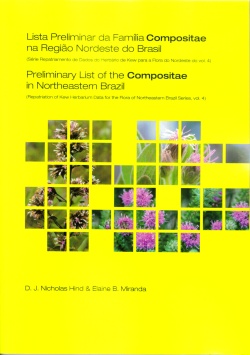 Preliminary List of the Compositae in
Northeastern Brazil. D.J. Nicholas Hind & Elaine B.
Miranda. ISBN: 9781842462195. 104 pp. Paperback. $56.00
Preliminary List of the Compositae in
Northeastern Brazil. D.J. Nicholas Hind & Elaine B.
Miranda. ISBN: 9781842462195. 104 pp. Paperback. $56.00
A checklist of 486 species, in 143 genera, with entries listed alphabetically
and sorted by state, collector and number. The list brings together the results
of an examination of some 4,200 Northeastern Brazilian Compositae specimens; and
is the fourth title to be published in the current series. The introductory text
is presented in both English and Portuguese languages.
Artists' Kew: An Exhibition of Contemporary Works. J. Cloake & R. Strong (eds.). 2006. Artists' Kew reveals Kew in its charming detail as well as in its full natural beauty by the Thames. It is about people too: their interaction with those settings, and the settings in turn as public places for simple relaxation and fun as well as the backdrop for enjoyment of botanical delights. Indeed, Kew today is more popular than ever: with visitors to the Royal Botanic Gardens and The National Archives, and as a residential community. More than 50 artists particpated in the exhibition on which Artist's Kew is based. The charitable share of proceeds from the sale of their work is in support of Kew's plans to construct a purpose-built gallery to display the world's most important collection of botanical art and manuscripts. The contemporary art shown in this book builds upon kew's eclectic tradition: to inspire, to excite, to strengthen the foundations of our living heritage and to foster understanding of the breadth of activity in the Royal Botanic Gardens. 96pp. 289 x 230mm. Col. illus. Hardback, with jacket. ISBN 1 84246 143 5. $33.00
Ophrys: The Bee Orchids of Europe. H.A. Pedersen & N. Faurholdt. 2007. The genus Ophrys constitutes one of the most diverse and biologically fascinating groups of plants to be encountered in Europe, particularly the Mediterranean. This book offers an easy to use, comprehensive, introduction to the genus, throughout its European range, It can be used as a field guide, with keys, descriptions and numerous colour photographs, as well as a standard reference, with chapters on structure, biology, evoltuion and conservation. The classification is based on a broad species concept, offering an alternative to the finely split classifications of the genus that prevail in most recent field guides. Notes on hardy orchid cultivation, by Richard L. Manuel, and a chapter of ideas for field trips, complete the picture. 297pp. 234 x 156 mm. 226 col. photos. Line drawings. Distribution maps. Flexicover. ISBN 978 1 84246 152 5 $66.00
A revised classification of the genus and an assessment of specific delimitation
and nomenclature within the genus are presented in this monograph. The evidence
from DNA data has clarified the relationships and classification of the species.
The resurgence of interest in Cymbidium species has highlighted the taxonomic
questions that still remain in the genus. The recent rush of new species names
in the literature is assessed and nomenclature is clarified. Extensive fieldwork
in tropical and subtropical Asia, the Malay Archipelago and Australia has
allowed the examination of many species in their wild habitats, contributing
valuable information concerning the ecology, natural variation of wild
populations and conservation assessments for Cymbidium species, and are provided
here for the first time. Cymbidiums are easy to grow, undoubtedly one of the
main reasons for their popularity in horticulture. Suitable environmental
conditions and composts for cultivation are recommended, while detailed
cultivation techniques for the species are discussed by Michael Tibbs, a leading
commercial orchid grower. ISBN: 978 1 84246 147 1. 369 pp., over 200 maps, line
drawings, color photographs and 38 full color paintings. Hardcover. $95.00
Orchids of Madagascar.
2nd Edition. Johan and Clare Hermans, David Du Puy,
Philip Cribb and Jean Bosser. 2007. ISBN: 9781842461334. 464 pp. Hardcover.
$150.00
Almost 1000 orchid species comprise 10% of Madagascar’s higher plant diversity;
a remarkable 85% of these unique to the island. Madagascar’s orchids are highly
desirable for their beauty and strangeness, and many now are under enormous
threat from deforestation and industrialization. The new edition of the classic
Orchids of Madagascar now illustrates over 250 orchids, and line drawings of new
species are added in an appendix. Almost 100 changes to nomenclature are
included and species descriptive notes extended to provide a wealth of
information on distribution, habitat and flowering times. All the most essential
references are included in the bibliography, with new entries accompanied by
concise annotations. This is still the one essential book for botanist, orchid
enthusiast, ecologist, environmentalist and field worker who need to have the
complete picture on Madagascar’s orchid flora.
Atlas of the Vegetation of Madagascar
Vegetation / Atlas de la Vegetation de Madagascar (text in English and French).
Justin Moat and Paul Smith. 2007. ISBN: 9781842461983. 124 pp. Hardcover.
$160.00
Madagascar is the world’s fourth largest island, and is recognized as one of the
world’s top ten hotspots for biodiversity. It is estimated that there are about
10,000 plant species on the island. Of these, 80 % or more occur nowhere else.
Man arrived in Madagascar just 2,000 years ago and since has cleared much of the
island’s forest. Supported by the Critical Ecosystem Partnership Fund, this
atlas gives a history of vegetation mapping in Madagascar, the methodology used
in compiling this atlas and detailed descriptions of each vegetation type,
illustrated with photographs and diagrams. Trends in deforestation, extent of
occurrence and levels of protection are assessed for each vegetation type. The
atlas itself comprises 36 detailed A3 maps, all in high resolution colour,
detailing the extent of each vegetation type, roads, trails, rivers, airports
and reserves, and a full place name index.
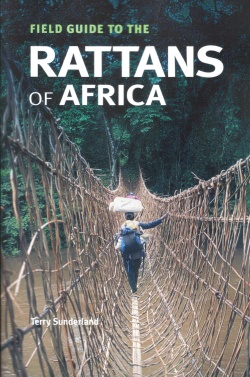 Field Guide to the Rattans
of Africa. Terry Sunderland. 2007. ISBN: 781842461808. 68
pp. Paperback. $40.00
Field Guide to the Rattans
of Africa. Terry Sunderland. 2007. ISBN: 781842461808. 68
pp. Paperback. $40.00
Africa’s rattans are the basis for many rural crafts and economies and urban
based industries, and have the potential to become a major crop on the world
markets as a non-timber forest crop. Written for the worker in the field,
whether scientist, forester or farmer, Field Guide to the Rattans of Africa is a
easy to use guide to all 22 species found in Africa, their ecology, distribution
and sustainable management. Descriptions are based largely on leaf and stem
characteristics – not flowers and fruits. More than 120 colour photographs,
meticulous line drawings and distribution maps illustrate the text. Colloquial,
vernacular and common names are included, with notes on local uses, trade and
conservation status. To aid botanists collecting specimens, some very practical
advice on handling these prickly plants are included.
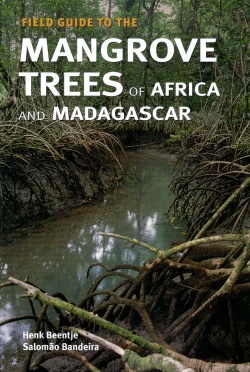 Field Guide to the Mangrove Trees of
Africa and Madagascar. Henk Beentje and Salomão Bandeira.
2007. ISBN: 781842461358. 91 pp. Paperback. $54.00
Field Guide to the Mangrove Trees of
Africa and Madagascar. Henk Beentje and Salomão Bandeira.
2007. ISBN: 781842461358. 91 pp. Paperback. $54.00
Growing on the edge of land and sea, mangrove trees are adapted to an amazing
range of environmental factors; they cope with changing salt levels, low soil
oxygen, and ever-changing water levels and protect shorelines against tsunamis
and cyclones. Extensively illustrated Field Guide to the Mangrove Trees of
Africa and Madagascar identifies all the species found in Africa and provides a
valuable insight into how they contribute to conservation coastal defence
systems, as a shelter for fishery species, and as an important habitat type in
its own right.
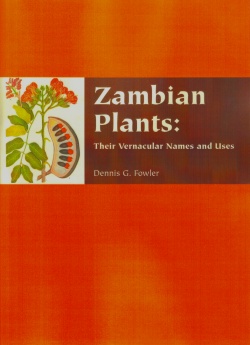 Zambian Plants: Their Vernacular Names
and Uses. Dennis G. Fowler. 2007. ISBN: 781842462126. 304
pp. Paperback. $100.00
Zambian Plants: Their Vernacular Names
and Uses. Dennis G. Fowler. 2007. ISBN: 781842462126. 304
pp. Paperback. $100.00
Zambian plants: their vernacular names and uses is a comprehensive list of
vernacular names used by the millions of rural Zambians who rely on bush
products in their everyday lives. It is also the most comprehensive review of
the uses of Zambian plants ever published, listing some 8,181 examples of plant
use. Even in this technological age, it is worth remembering that 65% of the
drugs that we use in treating cancer are derived from plants. There may well be
effective cures in this book that have not yet found wide use, and deserve to do
so. This book will be of great value to a wide range of people, including
botanists, conservationists, foresters, agriculturalists, pharmacologists,
economists, teachers and students.
World Checklist of
Dioscoreales. Rafaël Govaerts, Paul Wilkin and Richard M.
K. Saunders. 2007. ISBN: 9781842462003. 84 pp. Paperback. $50.00
Dioscoreales are a small but systematically and economically significant order
of monocotyledons. The most diverse and important member is the yam genus,
Dioscorea L., a source of dietary starch at macroeconomic to rural community
levels. Other species of Dioscorea provided the chemical basis of corticosteroid
drugs and oral contraceptives. Ally families comprise the unusual, largely
achlorophyllous (heteromycotrophic) Burmanniaceae and the relatively
unspecialised Nartheciaceae. The World Checklist of Dioscoreales lists all
validly published names of yams and their allies, providing the source of their
publication and indication of which names are currently accepted and which are
synonyms, making it a standard nomenclatural reference for further research into
this important family
World Checklist of
Cyperaceae. Rafaël Govaerts and David Simpson. 2007.
ISBN: 9781842461990. 780 pp. Paperback. $196.00
The sedge family, Cyperaceae, is the third largest family of monocotyledonous
plants. They are of significant economic importance, especially among rural
communities in the tropics, where sedges are intensively used. The World
Checklist of Cyperaceae provides a single source guide to the correct names of
all sedges, the source of their publication and indication of which names are
currently accepted and which are synonyms. It will be a standard nomenclatural
reference for further research into this important family. This makes it Is an
invaluable reference for agriculturists, horticulturists, ecologists,
conservationists and plant biologists
*JUST REPRINTED* Legumes of
the World. G. Lewis. 2005.
This is the first comprehensive guide to world legumes, describing and
illustrating all 727 genera.
Legumes contribute enormously to the world's economy - through food and drink,
pharmaceuticals and medicine, biotechnology, building and construction,
textiles, furniture, horticulture, paper and pulp, fertilizers, chemicals, pest
control and ecotourism. This book spotlights as yet untapped economic potential
and for the first time places genera in a modern systematic framework.
Containing over 1,000 illustrations - colour photographs and line drawings -
this is a lavish yet much needed reference for botanists and other professionals
involved with legumes. ISBN: 1900347806. 592 pp., Colour
photographs, line drawings. Hardcover. $120.00
To order any of these publications, just mailto:balogh@balogh.com
Back to our Home Page